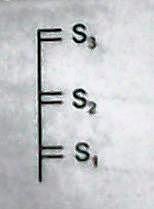Can you calculate average speed?
 S
1
,
S
2
&
S
3
are the different sizes of windows 1, 2 & 3 respectively, placed in a vertical plane. A particle is thrown up in that vertical plane. Average speed of the particle passing the windows may be equal if:
S
1
,
S
2
&
S
3
are the different sizes of windows 1, 2 & 3 respectively, placed in a vertical plane. A particle is thrown up in that vertical plane. Average speed of the particle passing the windows may be equal if:
(Assume that the speed of the particle is sufficient so that it crosses all the windows.)
Try more from my set Classical Mechanics Problems .
This section requires Javascript.
You are seeing this because something didn't load right. We suggest you, (a) try
refreshing the page, (b) enabling javascript if it is disabled on your browser and,
finally, (c)
loading the
non-javascript version of this page
. We're sorry about the hassle.
1 solution
The average speed between bottom point and top point of window S1, S2 & S3 will be different. In S1 average speed will be highest. So correct answer will be Si should be wider than S2 and S2 wider than S3
Yes s1>s2>s3 how they got none of these
Log in to reply
See for S 1 , if initial and final velocity be V i 1 and V f 1 respectively, the average velocity will be 2 V i 1 + V f 1 , similarly for S 2 it will be 2 V i 2 + V f 2 and for S 3 it will be 2 V i 3 + V f 3 . And we all know that ∣ V i 1 ∣ > ∣ V f 1 ∣ > ∣ V i 2 ∣ > ∣ V f 2 ∣ > ∣ V i 3 ∣ > ∣ V f 3 ∣ . Now you can check yourself which will be the correct answer.
When a particle is moving in uniform acceleration the average speed of particle between two points can be written as 2 V i + V f where V i & V f are the speed of particle at initial & final position respectively.
Since V i + V f can never be equal whatever be the length of windows S 1 , S 2 & S 3 , so average speed of particle can never be equal for any length of S 1 , S 2 & S 3 .